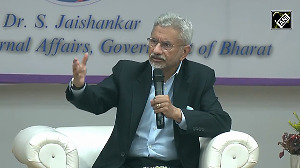The Indians appear to be in the driver's seat as far as the Gabba goes. The honours of the first day belonged to the Australians who batted aggressively to average a healthy four-plus runs per over. I am sure captain Sourav Ganguly would have had a disturbed sleep that evening pondering over his decision to ask the opponents to bat on Day 1.
The decision to bat or to field first has been a major debate in team meetings for a long time. The batsmen always feel that on the first day of such a rigorous tour, it's important that the bowlers make the best use of the prevailing conditions, while not putting the batsmen to test in such an alien set-up. It is also believed that it helps the batsmen understand the behaviour of the wicket in terms of bounce and movement and prepare their innings for that particular strip. On the contrary, a bowler always loves to bowl last in a match with a decent target on board. This, obviously, can happen only if the captain opts to bat first.
History reveals that most Test matches are won when a team is defending a decent total in the last innings. The lessons our bowlers have learnt is that they don't require to come up with big swing or movement. Instead, it is the subtle movement of the ball within the stumps from the right areas that are likely to earn them wickets.
It was a great sight to see the cheerful Zaheer Khan making inroads into the Australian batting line-up. The team can't expect anything more than to see the leader of the pack bowling well to unsettle the Australians from a good position. This five-wicket haul at the beginning of the tour tells you more about the quality of Zaheer. It's true that the conditions assisted the bowlers. But still someone had to put the ball in the right places.
Normally, it takes some time for the bowlers to adapt to the wicket and the one who comes to terms with it quickly reaps rewards. Adaptability is also a key factor in differentiating the good bowlers from the rest. Ajit Agarkar, who had a pretty ordinary first day, started off really well on the second day to bowl a great line showing more control. On Day 1 he looked as if he was wavering while striving for that extra pace. But when operating at a regulated pace, he not only found accuracy but also moved the ball in an alarming fashion.
It is true that results are encouraging when bowlers from both ends find the right spots. The saying, 'bowlers hunt in pairs', backs this up. Ashish Nehra, who could be equally devastating in such conditions, is getting into the groove and coming back into the game after a surgery, that itself being a great learning process. The intricate changes that one's body goes through after an operation to de-stress the load from the injured part should not have a huge bearing on his natural bowling action. I only wish Ashish gets back to form to make this attack more incisive.
Damien Martyn sacrificing his wicket for his skipper's fault and Steve Waugh's freaky hit-wicket dismissal brought the Indians back into the game. If not for Steve Waugh at the other end, I am sure Damien would not have left the crease. That, in a way, shows the respect the Australian captain commands from his teammates.
It is a real challenge for the Indian batsmen to stand up to the occasion. The batsmen will be expected to continue the good work already done by the bowlers. Mind you, the Aussie attack is not the best. If the rain-gods give way, a result could still be on the cards.
Chivach Media







 © 2025
© 2025